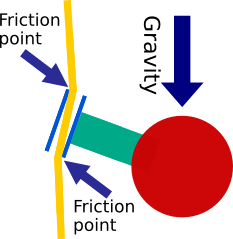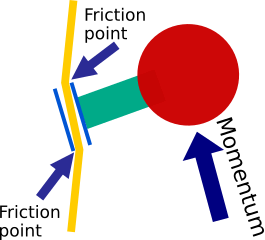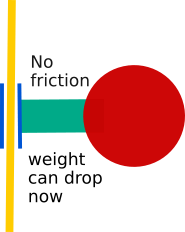Gravity, friction and momentum work together to keep the woodpecker pecking
I have always loved these kinetic folk toys that use physics to make unexpected motions. Let's take a closer look.
Before there were electric motors, grandfather clocks and giant tower clocks were powered by gravity. Weights were pulled up. As they slowly fell, they powered the gears of the clock. Similarly, our woodpecker gains potential gravitational energy as we lift it to the top of the rubber band. Once it starts going, the potential energy is converted to kinetic (moving) energy.

Falling objects turn
potiential stored energy
into kinetic moving energy
But how is the energy to make it bob metered out a little at a time? Why doesn't it just drop like a rock? If we just put a straw on the rubber band, it does just drop. But when we attach a lever (green) and a weight (red) to one side it twists the straw so the ends dig into the rubber band. The friction where the rubber meets the straws keeps the bird form dropping. In fact, some haver greater friction than others, and rubber is near the top of the list for having lots of friction.

Once we start shaking the weight (the bird), it bounces up until it digs into the rubber band, but tilted the opposite way. The energy from the weight is absorbed--captured, you might say--by the rubber band, and stored as potential energy. Not for long, mind you. The rubber band slings the bird back the way it came from.

If no new energy were put into the system, the woodpecker would just bounce back and forth a few times, each time a little less, finally becoming still. Whether it is bouncing balls or swinging pendulems or whatever, friction always robs some energy until they stop. But something interesting happens with our bird between each of the bobs. For just a fraction of a second in between the extremes of position, the straw is not digging into the rubber band. So it drops, just a little, but enough to turn a little bit of that potential energy into enough kinetic energy to keep things going.

Related links and cool videos
Joel Henriques

Joel Henriques is an Oregonian who has given the the woodpecker lots of class and beauty. He makes things with his young twins. You can read about Joel's woodpecker and find his template. Also you can see his website of amazing projects.
Interesting slow motion near the end of this video.
Arvid Gupta
Here are video instructions for how to make a woodpecker toy that uses a tiny spring. Here are the written instructions.
